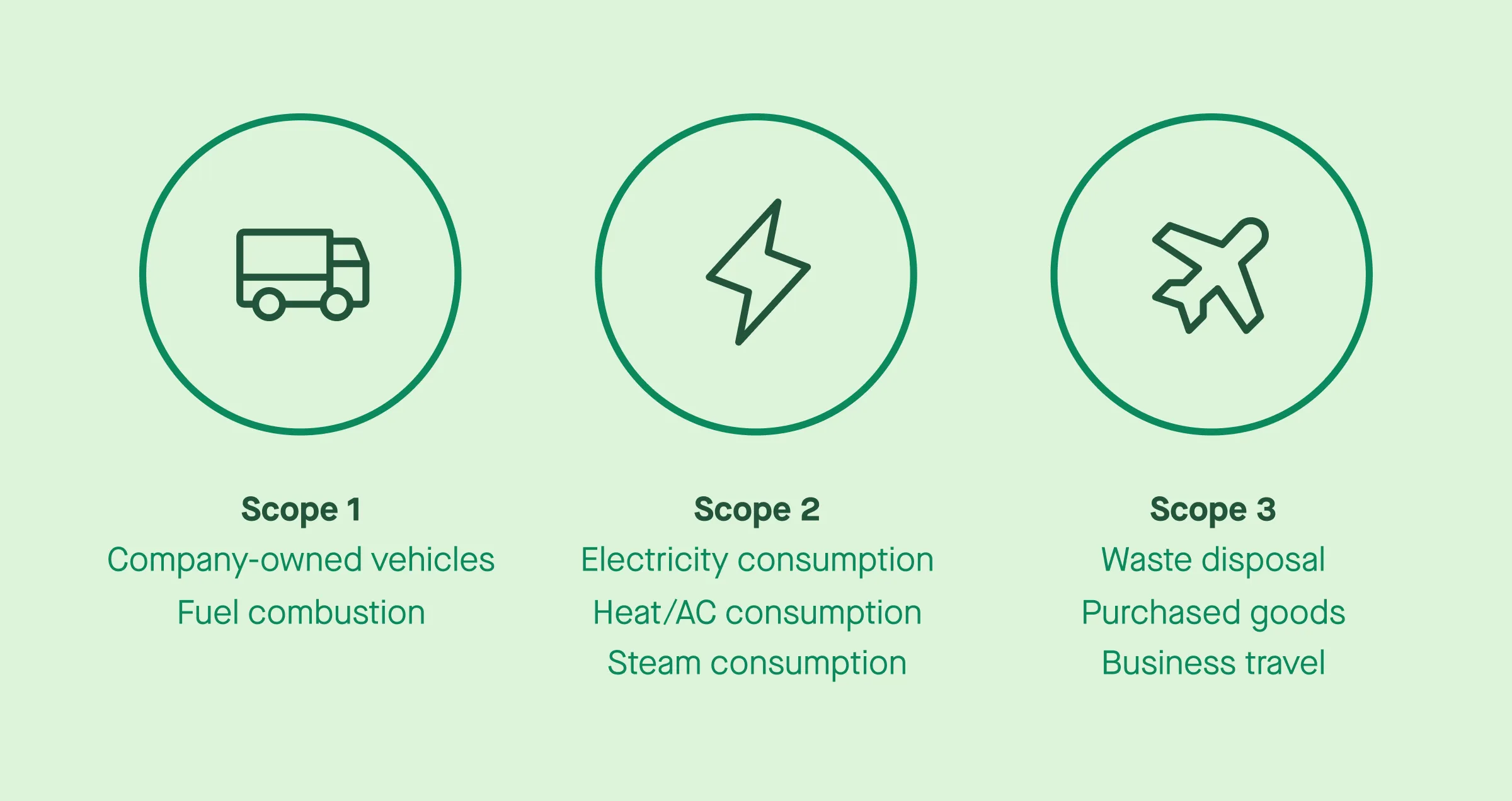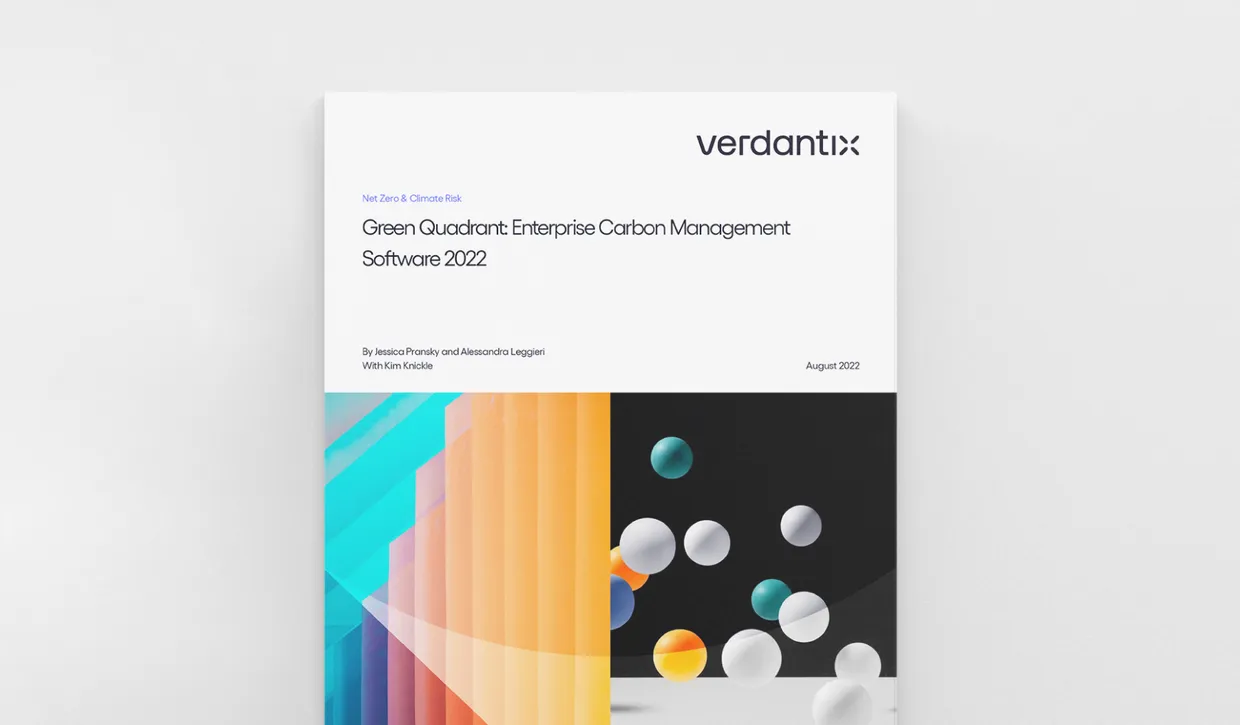As US businesses face rising expectations from regulators, investors, and customers, carbon tracking is emerging as more than an environmental obligation: it’s a driver of growth, innovation, and efficiency. Measuring greenhouse gas emissions helps companies understand where energy and resources are used, uncover ways to save money, and strengthen long-term business resilience. Done well, carbon tracking supports profitability while reducing emissions and protecting corporate reputation in a world shifting toward sustainable practices.
Carbon tracking for US businesses explained

Simplify carbon tracking with Sweep
What is carbon tracking?
Carbon tracking (also known as carbon accounting) is the process companies use to calculate and monitor the carbon emissions released from direct and indirect sources across their operations and supply chain. It is sometimes called carbon accounting or greenhouse gas accounting and forms the foundation for all credible climate action plans.
Companies track carbon emissions by collecting data on energy use, purchased electricity, transportation, and materials, then converting those activities into carbon dioxide equivalents (CO₂e) using emission factors, average values that translate each activity into measurable greenhouse gas output. These measurements show the full scope of a company’s carbon footprint and provide insight into where emissions come from.
The GHG Protocol, a modeling system developed by the World Resources Institute and the World Business Council for Sustainable Development, breaks emissions into three categories:
- Scope 1: direct emissions from owned or controlled sources, such as burning fossil fuels in company vehicles or onsite boilers.
- Scope 2: indirect emissions from purchased electricity, steam, heating, or cooling.
- Scope 3: all other indirect emissions that occur in the entire supply chain, including supplier operations, product use, and end-of-life waste.
Understanding these categories helps businesses identify their biggest emissions sources and measure progress toward emissions reduction and net zero targets. Carbon tracking should be a continuous process rather than a one-time exercise, so organizations can monitor changes, track progress, and demonstrate transparency to stakeholders.

Why US businesses should measure their carbon footprint
Businesses track carbon emissions for three main reasons: to meet regulatory requirements, to identify opportunities for cost savings and efficiency, and to build stronger market positioning in a low-carbon economy.
Regulatory compliance
New legislation in the United States is reshaping how companies measure and report greenhouse gas emissions. California’s SB 253 and SB 261 require large companies to disclose their direct and indirect emissions and climate-related financial risks. The Securities and Exchange Commission is also preparing disclosure rules that would require emissions reporting for public companies. These state and federal initiatives align with the Paris Agreement’s goals to limit warming to 1.5°C, and they signal that carbon tracking is now a matter of regulatory compliance as well as good governance.
Business growth and access to capital
Financial institutions are using carbon data to evaluate climate risk and determine lending terms. Businesses that measure greenhouse gas emissions accurately can access sustainable finance, attract ESG-focused investors, and strengthen relationships with partners that expect clear sustainability metrics. Companies that cannot demonstrate transparency risk exclusion from supply chains or investment portfolios. Carbon tracking provides the data that enables informed decisions and builds trust with investors and clients.
Cost savings and supply chain efficiency
Carbon emissions are often linked to inefficiency. Tracking carbon helps businesses pinpoint wasteful energy use, inefficient logistics, and resource-intensive operations. By analyzing their carbon footprints, companies can uncover ways to save money: through lower fuel bills, optimized transportation, or better materials management. In many cases, the same strategies that reduce carbon emissions also reduce costs, making emissions reduction a straightforward path to stronger margins.
Corporate reputation and customer loyalty
Consumers and corporate buyers increasingly prefer suppliers that take measurable steps to reduce their environmental impact. Companies that can demonstrate credible carbon tracking gain a competitive edge, strengthen their corporate reputation, and meet growing expectations for transparency and accountability. Publicly disclosing carbon data shows leadership and reinforces a company’s role in contributing to global net zero targets.
The business benefits of carbon accounting
Carbon tracking offers clear returns beyond compliance. It drives measurable improvements in performance, efficiency, and resilience.
Accurate measurement of greenhouse gas emissions allows companies to focus efforts where they have the biggest climate impact. It helps management teams make informed decisions based on real data rather than rough estimates. Businesses that track carbon emissions systematically can model emissions reductions, plan future investments, and quantify the payback from sustainability initiatives.
Many organizations find that integrating carbon management with financial performance opens new perspectives. Linking emissions data with cost centers allows them to calculate the return on investment from reducing energy consumption or switching to renewable power. The result is a clearer business case for climate action.
Carbon tracking also supports long-term strategy. Companies that understand their ecological footprint are better positioned to adapt to policy changes, new market expectations, and the global transition away from fossil fuels. With accurate carbon accounting, businesses can limit exposure to future carbon prices or taxes and demonstrate leadership in the shift toward a net zero economy.
Main carbon tracking methods
There are several ways to measure greenhouse gas emissions, each suited to different types of data and business activities.
Activity-based tracking
This approach uses measurable data: such as kilowatt hours of energy consumed, gallons of fuel used, or miles traveled, and applies emission factors to calculate the amount of carbon dioxide produced. It gives a precise picture of direct emissions and is often used for scopes 1 and 2.
Spend-based estimation
When activity data is unavailable, companies can estimate emissions using financial information. By multiplying spend categories by average emission factors, businesses can create a baseline for indirect emissions across their supply chain. While it provides a rough estimate, it is a useful starting point for identifying carbon hotspots.
Supplier-specific data
For organizations with complex supply chains, collecting data directly from suppliers improves accuracy. This method requires collaboration but produces more reliable results for indirect sources of emissions. Over time, supplier engagement helps standardize reporting and drives shared progress in reducing emissions.
Hybrid methods and life-cycle analysis
Most companies combine these methods, using detailed data where available and spend-based estimates elsewhere. Some perform life-cycle assessments to measure the total carbon footprint of products: from raw material extraction through manufacturing, distribution, use, and disposal. This approach helps companies understand the full environmental impact of their operations and products.
How software helps with carbon tracking
Managing carbon data manually through spreadsheets is time-consuming and error-prone. As reporting requirements expand and businesses collect data from multiple sites and suppliers, carbon tracking software becomes essential. A modern carbon tracker automates data collection, ensures accuracy, and turns information into actionable insights.
Streamlining data collection
Carbon tracking platforms integrate with enterprise systems to gather information on energy use, purchased electricity, logistics, and production. They combine these datasets automatically, applying consistent emission factors so results are comparable across departments and years. This automation reduces administrative effort and frees sustainability teams to focus on reducing emissions rather than compiling numbers.
Ensuring accuracy and auditability
Leading software platforms align with global standards such as the ghg protocol and ISO 14064. Every emission factor, calculation, and assumption is documented, making audit preparation seamless. Traceable data strengthens credibility during verification and ensures regulatory compliance under SB 253, SB 261, and future federal climate disclosure laws.
Improving transparency and engagement
Real-time dashboards show how emissions evolve across scopes, business units, and regions. This visibility enables teams to measure progress toward decarbonization targets and communicate results clearly to stakeholders. Many platforms also include supplier portals, allowing businesses to collect data across their entire supply chain and promote transparency from top to bottom.
Integrating financial and sustainability data
Advanced carbon management systems connect carbon tracking with financial performance. By linking emissions data to cost centers, managers can see where reducing emissions also reduces expenses. This integration allows businesses to model emissions reductions, forecast future costs, and justify investments in efficiency or renewable energy with quantifiable financial returns.
Supporting continuous improvement
Software helps companies measure, manage, and refine their climate action strategies. Automatic updates keep methodologies current with evolving standards, while analytics highlight areas for improvement. Over time, this consistent tracking process builds a data foundation for stronger reporting, better decision-making, and credible progress toward sustainability goals.
From measurement to opportunity
Carbon tracking is no longer just about combatting climate change – it’s about using real data to make smarter business choices. Companies that track carbon emissions effectively gain the insight needed to stay ahead of regulation, reduce costs, and strengthen their position in an economy focused on sustainability and transparency.
The process begins with understanding emissions sources and collecting accurate carbon data. From there, companies can implement reduction plans, collaborate across their supply chain, and monitor the results through continuous carbon tracking. As businesses measure greenhouse gas emissions over time, they build resilience and efficiency, turning sustainability into a measurable source of competitive advantage.
In the coming years, as more countries adopt policies aligned with the Paris Agreement and climate disclosure becomes standard practice, businesses that already have strong strategy to reach Net Zero will be best placed to grow. They will meet regulatory requirements with ease, demonstrate leadership to investors and customers, and contribute meaningfully to global efforts to limit warming.
Carbon tracking works because it connects sustainability with profitability. It reveals where resources are wasted, where investments in efficiency will pay off, and how companies can lower emissions while strengthening operations. For US businesses looking to future-proof their growth, mastering carbon tracking today is not just good for the planet, it’s good for business.
Sweep can help
Sweep is a carbon and ESG management platform that empowers businesses to meet their sustainability goals.
Using our platform, you can:
- Conduct a thorough assessment of your carbon footprint.
- Get a real-time overview of your supply chain and ensure that your suppliers meet your sustainability targets.
- Reach full compliance with the CSRD and other key ESG legislation in a matter of weeks.
- Ensure your sustainability information is reliable by having it verified by a third party before going public.




